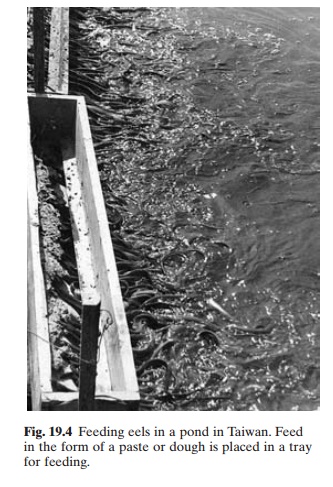Chapter: Aquaculture Principles and Practices: Eels
Feeds and grow-out of adult eels
Feeds and grow-out of adult eels
In the brackish-water vallis of the Mediter-ranean, the elvers enter the
lagoons and estuaries and grow in the sheltered areas, feeding on the natural
food available. In modern vallis, special eel ponds are built for monoculture
and over-wintering. More intensive stocking and artificial feeding are now practised
to improve production. A stocking rate of 50/ha is common and it takes four to
seven years for these elvers to grow to market size. They are caught in
‘lavorieri’ (traps) when they swim against the tidal inflow at the sluice
gates.

In Japanese eel farms (fig. 19.3), raising of adult eels starts with seed eels weighing about 20 g. They are grown to about 150 g in ponds ranging in size from 3300 to 10 000 m2. The most convenient size of pond is usually about 3300 m2 (depth about 1 m). The best results are obtained in areas with a plentiful supply of warm water. Generally, the dikes are lined with wooden planks or stonemasonry, to prevent eels from burrowing into the dike. The average stocking rate is 500–700 g per m2. The feeding rate is about 10 per cent of the total weight of the stock, if fresh fish are used as feed. The compound feeds used generally contain 46–52 per cent protein and 3–5 per cent fat. During the early years of eel culture in Japan and Taiwan, silkworm pupae formed a major item of feed, but in recent years compound feeds are more commonly used.
The feed, usually in a powder form, is mixed with water to make a paste.
The paste is placed on a mesh tray in the feeding area and the eels go through
the net mesh or climb on to the tray to feed (fig. 19.4). The uneaten feed can
easily be removed. Eels feed avidly at warmer temperatures on clear, windy and
dry days.

Most eel ponds are provided with motorized paddle wheels to aerate the
water, particularly at night and in the early mornings. Some farms in Japan and
Taiwan have a corner of the pond partitioned off with wooden boards into a pool
at the inlet, with a suitable entrance for the eels. Water wheels are installed
in these pools.
During the night, when the oxygen concentration is reduced, the eels
congregate in these pools. Some farms in Taiwan install compressed air blowers
at the pond bottom to increase the oxygen supply.
As the growth rates of individual eels differ considerably, it is
essential to sort out the stock and restock them in separate ponds, to obtain
eels of marketable size. Japanese consumers prefer 100–200 g eels, and this
size is reached in one year after stocking. In Taiwan and Europe larger eels
are preferred, and this requires a second year of growth. Japanese eel growers
export large eels to Europe.
Very high production rates of up to 26 tons/ha have been achieved in
recent years in intensive farming systems, particularly with the use of heated
water or in running water ponds.
Related Topics